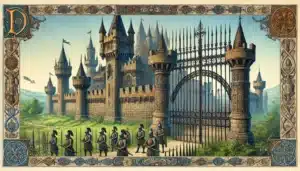At a Glance
- Traditional Wood Privacy Fence
- Lattice Wood Fences
- Decorative Wood Fence Panels
- Choosing the Right Wood Fence for Your Privacy Needs
- Wood Fences FAQs
There’s no place like home, isn’t it? It’s that private sanctuary where you can let your hair down and be yourself. It’s your personal space where you can enjoy solitude or quality time with your loved ones. But what happens when this private retreat is at the mercy of prying eyes? Suddenly, the haven becomes less inviting. That’s where the importance of privacy in our homes comes into play.
In this bustling world where houses are often built closer together, maintaining privacy in our yards can be a challenge. Thankfully, there’s a popular solution that homeowners have been relying on for centuries – wood fences. Not only do these structures provide the much-needed seclusion, but they also add to the aesthetic appeal of your outdoor spaces. Today, we will delve into the world of wood fences and explore seven different ideas that promise both privacy and visual charm.
Traditional Wood Privacy Fence
Let’s take a stroll down memory lane and start with the most timeless design – the traditional wood privacy fence. This classic style usually features tightly-spaced vertical boards with no gaps in between, ensuring complete privacy. The top can be flat for a simple look, or it can be styled into a decorative design for added flair.
When it comes to the type of wood used, cedar, pine, and spruce are among the most common choices. Cedar is highly durable and naturally resistant to decay and insects, making it a popular choice despite its higher cost. Pine, on the other hand, is more affordable but requires a protective coating to prevent decay. Spruce is another budget-friendly option, but it doesn’t fare well in moist conditions.
The traditional wood privacy fence has its own set of advantages. Besides offering utmost privacy, it’s also sturdy and can withstand harsh weather conditions. Plus, it provides a neutral backdrop that can blend in with various outdoor styles. However, it’s not all rainbows and butterflies. This style can feel a bit too closed off for some, and the lack of gaps means limited airflow.
Vertical Slat Fence
Moving on from the classic design, let’s introduce a more contemporary style – the vertical slat fence. As the name suggests, this design features vertically-aligned slats. But unlike the traditional style, these slats are spaced out, creating an interesting visual pattern.
The beauty of a vertical slat fence lies in its versatility. You can play around with different variations such as alternating widths or staggered heights to create a unique look. For instance, using wide slats alternated with narrower ones can add a touch of modernity to your yard. Similarly, having slats of varying heights can make the fence look less monotonous and more dynamic.
Despite its modern appeal, a vertical slat fence doesn’t compromise on privacy. The spaces between the slats are usually small enough to prevent outsiders from peeking in. Plus, this design allows for better airflow and natural light, making it a great option for those who want privacy without feeling completely walled off.
Lattice Wood Fences
For those who want to add a touch of elegance and sophistication to their yards, lattice wood fences are the way to go. The lattice wood fence is a unique blend of functionality and style, offering homeowners an aesthetically pleasing option that doesn’t compromise on privacy.
The lattice wood fence is characterized by its distinctive pattern. This pattern, typically consisting of crisscrossed strips of wood or metal, creates a series of diamond or square-shaped spaces. It is this unique design that sets lattice fencing apart from other wood fence styles, transforming a simple barrier into a statement piece.
One of the standout benefits of lattice wood fences is their versatility. This style of fencing can enhance the aesthetic of any yard, regardless of size or landscape design. Lattice fencing complements a wide range of architectural styles, from traditional to contemporary, making it a versatile choice for any homeowner. Plus, the open design of the lattice pattern allows for the incorporation of plant life. Vines, flowers, and shrubs can weave their way through the lattice openings, creating a living wall that adds a touch of natural beauty to your outdoor space.
Board-on-Board Fencing
Next on our journey through wood fence ideas for privacy is the board-on-board fence. This style, also known as a “neighbor-friendly” fence, offers an elegant solution for those seeking total privacy in their yard.
Board-on-board fencing is constructed by placing wooden boards on both sides of the fence, with each board overlapping the one below it. This overlapping pattern ensures that there are no gaps through which outsiders can peep, providing the ultimate in privacy. Plus, because the design is identical on both sides, it looks equally appealing whether you’re inside or outside the yard.
Aesthetically speaking, board-on-board fences offer a visually pleasing look that works well with a variety of landscape designs. The overlapping boards create a textured, three-dimensional effect that adds depth and interest to your outdoor space. Whether stained to showcase the natural beauty of the wood or painted in a color that complements your home’s exterior, a board-on-board fence is sure to enhance the overall look of your property.
Decorative Wood Fence Panels
Now, let’s explore the option of decorative wood fence panels for privacy. These panels, which offer an artistic twist on traditional fencing, are a great way to inject personality into your yard while still ensuring privacy.
Decorative wood fence panels come in a wide array of designs and patterns. From intricate geometric shapes to whimsical artistic elements, there’s a design to suit every taste. These panels can serve as standalone art pieces within your garden, or they can be incorporated into a larger fencing system for a truly unique look.
Despite their artistic flair, decorative wood fence panels don’t skimp on functionality. They provide the same level of privacy as traditional fencing options, making them a practical choice for homeowners. Plus, because they’re made from wood, these panels can be stained or painted to match your home’s exterior, ensuring a cohesive look throughout your property.
Horizontal Wood Fence
The horizontal wood fence breaks from the traditional vertical pattern that we’re all accustomed to. It offers a fresh perspective, literally and figuratively, on how a boundary or a privacy fence should look like. The parallel lines create a clean, minimalist look that exudes a contemporary vibe, perfect for homes that lean towards modern design.
But more than just aesthetics, there are practical benefits to choosing horizontal boards for your privacy fence. One notable advantage is the illusion of space it creates. The horizontal lines draw the eyes sideways, making your yard seem wider and more spacious. This can be particularly beneficial for smaller properties, helping to maximize their perceived area.
However, it’s important to note that while horizontal wood fences are undeniably attractive, they may require more support than their vertical counterparts due to the nature of their construction. This might mean additional costs in terms of materials and labor. Despite this, many homeowners find that the unique aesthetic appeal and spatial benefits of horizontal wood fences are well worth the investment.
Natural Wood Fences
Another trend gaining traction is the use of natural wood materials, such as bamboo or reclaimed wood. These sustainable materials not only provide privacy but also add a touch of organic beauty to any yard.
Natural wood materials offer an authentic, rustic charm that can’t be replicated by synthetic alternatives. Bamboo fences, for instance, can instantly transform your backyard into a tranquil Zen garden. Reclaimed wood, on the other hand, provides a unique, aged character that adds depth and interest to your outdoor space.
Sustainability is another compelling reason to choose natural wood fences. By choosing bamboo or reclaimed wood, you’re making an environmentally-friendly choice. Bamboo is a fast-growing plant that regenerates quickly, making it a renewable resource. Reclaimed wood, which is repurposed from old structures, also reduces the demand for new timber, helping to conserve our forests.
However, as with any material, natural wood fences have their set of considerations. While they are generally durable, they may require regular maintenance to keep them in good condition. This might include sealing or staining to protect against moisture and pests. Furthermore, certain types of wood may weather or change color over time, which could affect the overall aesthetic of your fence.
Choosing the Right Wood Fence for Your Privacy Needs
As we’ve explored in this guide, there are several wood fence options available to provide privacy for your outdoor space. Each style offers its own unique benefits, from the total coverage of board-on-board fencing to the modern allure of horizontal wood fences.
When deciding on the right wood fence for your property, consider not just aesthetics but also practical aspects such as maintenance and cost. Ultimately, the best choice will depend on your personal preference, budget, and specific privacy needs.
With so many options to choose from, there’s no reason why you can’t have both style and functionality in your privacy fence. Whichever wood fence style you choose, it’s sure to enhance the beauty and privacy of your outdoor living space for years to come. With the right wood fence, you can add privacy without sacrificing aesthetics, bringing both functionality and beauty to your backyard.
Wood Fences FAQs
Do I Need a Fence?
Fences offer privacy, security, and can enhance the aesthetic appeal of your property. If you value these aspects, then yes, you might need a fence.
How Much Will Fencing Cost?
The cost of fencing depends on the materials used, the size of the area, and labor costs. It would be best to get quotations from several contractors to get an idea of the potential expense.
Which Is the Cheapest Fencing Material?
While prices can vary, generally, chain-link fences tend to be the most affordable option. However, if you’re after aesthetics and durability, wood fences, although more expensive, may be worth the investment.
What Should You Expect From a Natural Wood Fence?
Natural wood fences are charming, sturdy, and can last for many years with proper maintenance. However, they can be susceptible to pests like termites and may require treatment to prevent decay.
How Deep Should the Posts Be?
As a rule of thumb, fence posts should be buried at least a third of their total length into the ground. For instance, a 9-foot post should have 3 feet underground.
How Far Apart Should the Posts Be?
Typically, fence posts should be spaced between 6 to 8 feet apart. The exact spacing can depend on the type of fence panel or the design you choose.
How Much Concrete for Each Post?
Generally, you’d need around 50 pounds of concrete for a standard 3-foot deep, one-foot diameter hole.
What Types of Fences Are Available?
There are various types of fences available including picket fences, privacy fences, decorative fences, and split rail fences. The choice depends on your requirement and taste.
What Type of Wood is Best for Privacy Fencing?
Cedar, pine, and spruce are commonly used for privacy fencing due to their durability and resistance to rot and insects. Cedar is often favored for its rich color and aroma.
How Long Should a Wood Fence Last?
With proper maintenance, a wood fence can last anywhere between 15 to 20 years. Factors like the type of wood used and the local climate can affect its lifespan.



